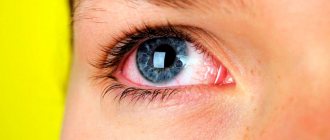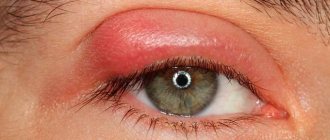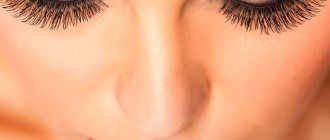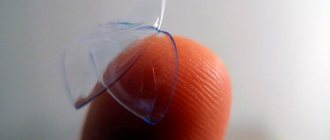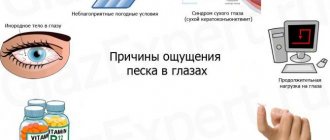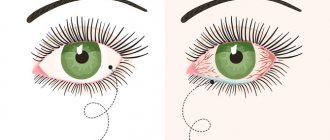Kazakh youth are being conquered by a new drug, reports KTK TV channel. The substance “cyclopentolate hydrochloride,” which ophthalmologists prescribe as eye drops, is used by young people for other purposes: they drop it into the nose.
Almaty resident Dinara is sure that her son uses this substance. According to her, she suspected something was wrong when she saw “Naphthyzin” on her son several times, although he did not have a runny nose. A potential future daughter-in-law enlightened her about her son’s hobby: Kazakh youth began to become interested in Cyclomed drops.
“Three times a day they stop by the pharmacy, there are three of them, and buy themselves one ampoule in plastic boxes, like Naphthyzin. And they do this: they tear off this label and leave it like that. Either, if they go home, they pour it into a Naphthyzin bottle, or they put a Naphthyzin sticker on this bottle,” the woman said.
Her 24-year-old son eventually admitted that he had been using these drops for four years. According to him, four years ago he tried the drops out of curiosity, and then couldn’t stop.
“Many parents don’t even understand what’s happening to their child. They can’t even draw a parallel with some drops. How I lived in ignorance and did not understand what was happening to my son,” Dinara laments.
O is not so easy to buy without a prescription, but the task is not impossible.
“No one has ever put it in their nose. Drug addicts, having learned about this, began to instill this eye medicine into their noses. In the sinuses, in the nasal mucosa, we have a lot of blood vessels. The substance is directly absorbed and from the blood enters the brain, so there is a quick and strong toxic effect,” said narcologist Mars Berimbaev.
According to narcologists, from a few drops in the nose a person completely loses his sense of reality and then forgets everything that happened to him. Cyclomed is dangerous not only because of addiction, but also because of overdose. After a violation of the mental reaction, seizures, tachycardia, coma and death are possible.
In Russia, Cyclomed has been under strict control since the fall of 2020, and pharmacies are accountable for every bottle sold.
Only janitors deal with one of the physical evidence of teenage drug addiction. They are the ones who sweep away traces of psychedelic pastime in the morning. Ordinary Bishkek courtyards serve as meeting places for schoolchildren, and after them not only empty cigarette packs are left behind, but also bottles of the drug Cyclomed. Information: “Cyclomed” is an eye drop used for diagnosing eye diseases, treating various diseases, and during surgical interventions. At first glance, it looks like an ordinary medicine. But frivolous youths learned to use it for other purposes. One of them, who wished to remain anonymous, told his story: “It happened in the eighth grade.” Once, in one of the courtyards of the Alamedin microdistrict, guys I knew taught me a new way to get high - with the help of Cyclomed. At that time it cost about 180 soms. The “medicine” was dripped into the nose, 3-4 drops each, and waited 15 minutes for the desired effect. I remember how we all laughed for no reason. Afterwards, I felt that I couldn’t walk home on my own, so I called my brother and he picked me up. In response to his questions about my slightly inadequate state, I justified that I had been poisoned by samsa. The second time I increased the dose, and the sensations were different. For example, multi-colored spots floated in my eyes, and then I completely passed out. I woke up at the house of a friend who was “on duty” and therefore did not drink anything. This was my last experience, because I am a heart patient and probably an idiot. Now the price of Cyclomed is 250 soms. It is freely available in pharmacies, and therefore a reasonable question arises: “Why?” The Central Pharmacy ignored my interest and simply hung up. The Pharmaceutical Inspectorate of the Department of Drug Supply and Medical Equipment under the Ministry of Health of the Kyrgyz Republic also did not want to give an intelligible answer. Meanwhile, the problem of teenage drug addiction is one of the most pressing social problems, and the fight against this evil is the task of not only doctors, but also parents. Although they rarely notice the unusual behavior of their children, justifying the oddities as adolescence. Kristina Bryuzgina, a child psychologist at the Republican Center for Narcology, spoke about infrequent cases of voluntary visits to narcologists. According to her, parents rarely bring their child to a psychiatrist in a timely manner. Usually the guys end up in toxicology, and only there the cause of the chemical poisoning is revealed. It is more difficult with Cyclomed - it is difficult to detect in the blood. Teenagers even pour the medicine itself into Naphthyzin bottles so as not to arouse suspicion. By the way, girls have already begun to use the drug with psychotropic effects. The victims of addiction themselves blame the difficult situation in the family for everything - parental divorce, death of loved ones, domestic violence, difficult relationships with peers, and even simple curiosity. “I think that parents should have conversations about drugs and their terrible consequences,” the psychologist noted. Psychiatrist-narcologist Irina Alymkulova also spoke about the deadly dangers of teenage hobbies. — These eye drops are instilled into the nose, because its walls contain many blood vessels, and the drug, along with the blood, enters the brain, after which intoxication occurs. It is quite possible to become dependent on it. Teenagers like colored hallucinations and over time they get used to the abnormal state of the body. But changes in the brain are irreversible. Mental disturbances, seizures, tachycardia will follow, and in cases of overdose - coma and even death. This applies to all other types of synthetic drugs. — Why do such a small number of people contact you? - Everything is very simple. Parents are afraid of leaving a stigma on their children's reputation, thinking that this will harm them later - when applying to university or looking for a job. But I hasten to reassure you that you can contact us anonymously for help; the patient will not be registered. — Do you agree that there are no former drug addicts? - Partly yes. After all, they more often turn to toxicologists, who treat not the cause, but the effect. — So how to fight the epidemic of teenage drug addiction? — I have an idea to create a youth anti-crisis center where young people could communicate with fellow sufferers, support each other, and find new hobbies. We published a series of articles about this in newspapers, because information is necessary. And the main thing is to limit access to psychotropic substances in pharmaceutical institutions.
Children
Rare cases of toxicity have been reported in children following accidental ingestion or topical application of excessively high doses. The toxic dose is 0.5 mg/10 kg body weight (single dose administration).
Symptoms: early - bradycardia and heart rhythm disturbances, less often - tachycardia, increased blood pressure. In severe overdose, hypothermia, sweating, loss of consciousness, coma, or respiratory depression may occur.
Adults
No cases of overdose have been reported.
Treatment
In case of overdose, stop using the drug and consult a doctor immediately. If necessary, emergency therapy is carried out in a specialized department of the hospital to ensure the maintenance of adequate respiratory function. As an emergency first aid, you can take activated charcoal.
Interaction with other drugs and other forms of interaction When using the drug simultaneously with MAO inhibitors or tricyclic antidepressants (and even several days after their use), an increase in blood pressure is possible.
Naphazoline may enhance the effect of alpha-adrenergic stimulation when used in combination with other agents that contain sympathomimetic amines or β-blockers (especially non-selective β1-blockers).
Special instructions and precautions
As a first-line treatment, it is recommended to rinse the nose with saline solution. This medicine is recommended for use as second-line treatment for a maximum of 5 consecutive days. This medicine should not be used for prophylactic purposes. Do not swallow.
Long-term use and excessive doses of the drug should be avoided, especially in children and the elderly.
Long-term use of drugs that reduce swelling of the nasal mucosa can lead to chronic swelling and atrophy of the mucous membrane, and the development of drug-induced rhinitis.
Patients who use high doses of the drug should be under medical supervision due to the possible occurrence of cardiovascular and neurological adverse reactions (hypertension, arrhythmia, palpitations, headaches, dizziness, drowsiness, insomnia).
If it is necessary to use naphazoline solution for a long time, it is necessary to interrupt treatment for several days every 5 days to avoid the development of tolerance.
Caution is necessary when simultaneous use of drugs that may increase blood pressure. Caution must also be exercised when performing general anesthesia with the use of anesthetics that increase the sensitivity of the myocardium to sympathomimetics (for example, halothane).
When used in combination with MAO inhibitors, there is a risk of a sharp increase in blood pressure, so naphazoline can be started no earlier than 15 days after stopping the use of MAO inhibitors.
1 ml of the drug contains 0.1 mg of benzalkonium chloride. Benzalkonium chloride may cause irritation and/or swelling of the nasal mucosa, especially with prolonged use.
The composition of the drug includes boric acid and sodium tetraborate. One drop (0.03 ml) contains about 0.369 mg of boric acid (equivalent to 0.065 mg of boron) and about 0.015 mg of sodium tetraborate (equivalent to 0.003 mg of boron). Thus, in total, 1 drop contains about 0.068 mg of boron. Nasal drops 0.5 mg/ml and 1.0 mg/ml contain equal amounts of boric acid and sodium tetraborate per unit volume. The maximum recommended daily dose for children is 24 drops of the drug 0.5 mg/ml, for adults - 24 drops of the drug 1 mg/ml. 24 drops contain approximately 1.632 mg of boron.
Fertility, pregnancy and lactation
Use during pregnancy and breastfeeding is not recommended due to the risk of accidental release of naphazoline nitrate into the systemic circulation. The use of the drug during pregnancy and breastfeeding is possible only in cases where the expected benefit to the mother outweighs the potential risk to the fetus and breastfed child. Before use, consult a doctor.
Use in children
The drug Naphazoline, nasal drops 0.5 mg/ml, is contraindicated in children under 7 years of age.
The drug Naphazoline, nasal drops 1.0 mg/ml, is contraindicated in children under 12 years of age.
The duration of use of the drug in children should not exceed 5 days.
Impact on the ability to drive vehicles and operate other moving mechanisms
The drug has no or minor effect on the ability to drive vehicles and operate moving machinery. With long-term use and/or use in a dose exceeding the recommended one, manifestations of the systemic effect of naphazoline on the cardiovascular system and other undesirable reactions may develop (see also sections “Side effects” and “Overdose”). When driving and/or working with moving machinery, as well as when planning such activities, the possibility of developing undesirable reactions that may affect attention and coordination of movements should be taken into account.
Description
Pharmacological properties
Pharmacodynamics. miramistin is a cationic surfactant with antimicrobial (antiseptic) effect.
The action of miramistin is based on the direct hydrophobic interaction of the molecule with the lipids of the membranes of microorganisms, leading to their fragmentation and destruction. In this case, part of the miramistin molecule, plunging into the hydrophobic portion of the membrane, destroys the supra-membrane layer, loosens the membrane, increases its permeability for large-molecular substances, changes the enzymatic activity of the microbial cell, inhibits enzyme systems, which leads to inhibition of the vital activity of microorganisms and their cytolysis.
Unlike other antiseptics, Miramistin has a highly selective action against microorganisms, since it has virtually no effect on human cell membranes. This effect is associated with a different structure of human cell membranes (much longer lipid radicals, which sharply limit the possibility of hydrophobic interaction of miramistin with cells).
Miramistin has a pronounced antimicrobial effect against gram-positive and gram-negative, aerobic and anaerobic, spore-forming and asporogenous bacteria in the form of monocultures and microbial associations, including hospital strains with multidrug resistance to antibiotics.
It has a detrimental effect on pathogens of sexually transmitted diseases - gonococci, Treponema pallidum, Trichomonas, chlamydia, as well as herpes viruses and human immunodeficiency. It has an antifungal effect on ascomycetes of the genus Aspergillus and genus Penicillum, yeast (Rhodotorula rubra, Torulopsis gabrata) and yeast-like (Candida albicans, Candida krusei) fungi, dermatophytes (Trichophyton rubrum, Trichophyton mentagrophytes, Trichophyton verrucosum, T. schoenleini, T. violaceum, Epi dermophyton Kaufman - Wolf, E. floccosum, Microsporum gypscum, Microsporum canis), as well as other pathogenic fungi (for example, Pityrosporum orbiculare (Malassezia furfur)) in the form of monocultures and microbial associations, including fungal microflora with resistance to chemotherapeutic drugs. Under the influence of miramistin, the resistance of microorganisms to antibiotics decreases. Miramistin has anti-inflammatory and immunoadjuvant effects, enhances local protective reactions, regenerative processes, activates nonspecific defense mechanisms due to modulation of the cellular and local humoral immune response, which accelerates recovery.
Pharmacokinetics. Miramistin has a local effect. There are no data on the possible penetration of the drug into the systemic circulation.
Mechanism of action of Cyclomed
When used according to the instructions, a drug from the group of m-anticholinergics has a direct effect on the visual muscles, which leads to pupil dilation. As a result, it becomes difficult for a person to see objects that are in close proximity to him and his face. Up close they blur, making it difficult to write and read. However, when therapeutic doses are used, the effect of the drops wears off quite quickly. After 8-12 hours, vision returns to normal.
The use of Cyclomed facilitates the work of ophthalmologists; it is much easier for them to examine the fundus of the eye and identify pathologies when the patient’s pupil is dilated. This facilitates diagnosis and makes it better and faster. The drug quickly penetrates the mucous membrane and begins its effect within 10 minutes. It is even used when examining and treating children.
Use of cyclomed intravenously
This is the greatest danger of this substance. Most drug addicts “pump cyclomed through their veins,” despite the fact that intravenous use is not included in the instructions at all. Since the prices for heroin and other opiates are constantly rising, and the financial situation of drug addicts is rapidly deteriorating, they begin to inject Cyclomed intravenously.
Why do drug addicts use Cyclomed? First of all, to obtain drug intoxication, euphoria and calmness, and escape from problems. After the injection, a person feels flying and incredible lightness, then drowsiness, hallucinations occur, and the addict finds himself in a world of illusions. The short-term effect of the drug pushes a person to use the drug again. Tolerance develops quite quickly, which contributes to the risk of overdose.
Indications
In the complex treatment of infectious processes in the anterior part of the eye (blepharitis, conjunctivitis, keratitis, keratouveitis) caused by gram-positive and gram-negative bacteria, chlamydia, fungi and viruses sensitive to miramistin, eye injuries, eye burns (thermal and chemical).
Prevention of ophthalmia of newborns, including gonococcal and chlamydial.
Prevention and treatment of purulent-inflammatory eye lesions in the pre- and postoperative period.
In the complex treatment of acute and chronic external otitis, chronic purulent mesotympanitis, otomycosis.
In the complex treatment of acute rhinitis.
Opinion of narcologists about Cyclomed
Unfortunately, Cyclomed is far from the only drug that has become popular among young people as an “easy” and inexpensive drug. Pregabalin, which is intended for epileptics, produces a different condition at high doses. It is not surprising that some young people began to buy it not to combat the symptoms of epilepsy.
Narcologists believe that it is quite difficult to develop dependence on Cyclomed. It does not provide the required range of pleasures for the addict, without giving pronounced euphoria.
However, this does not mean that Cyclomed is harmless and after one time of nasal use a person will no longer try it. For some people, these drops cause a feeling of calm, especially in small doses. Therefore, having received the desired relaxation, a person gradually forms a psychological dependence of the following type:
- Stressful situation;
- The need to calm down with the help of a drug;
- Temporary relief of anxiety.
As a result, the drug addict, always having Cyclomed at hand, simply cannot imagine any other way to relieve stress.
Video: what does the use of eye drops nosally lead to?
In this video, ophthalmologist Tatyana Borisova will tell you how they sell eye drops in pharmacies and how they circumvent the ban on dispensing without a prescription:
Application
Ophthalmology. for the treatment of infectious processes in the anterior part of the eye, adults and children over 12 years old are instilled into the conjunctival sac, 2-3 drops, children under 12 years old - 1-2 drops 4-6 times a day. The duration of treatment usually does not exceed 2 weeks.
In order to prevent complications in the pre- and postoperative period - 2-3 drops 3 times a day 2-3 days before surgery. After surgery - for 3-5 days, 1-2 drops 3 times a day.
To treat eye burns, after washing the eye with plenty of water, carry out frequent instillations (every 5-10 minutes) for 1-2 hours. For further treatment, the drug is used in adults and children over 12 years of age - 2-3 drops, in children under 12 years of age - 1-2 drops 4-6 times a day.
To prevent ophthalmia in newborns, immediately after birth, the child is instilled with 1 drop of the drug into each eye 3 times with an interval of 2–3 minutes.
Otolaryngology. When treating acute and chronic external otitis, otomycosis, adults and children over 12 years of age are instilled with 3-5 drops 4-6 times a day, for children under 12 years old - 2-3 drops 4-6 times a day.
A gauze turunda moistened with the drug can be inserted into the external auditory canal 4–6 times a day for 10–14 days (instead of instillation).
For chronic mesotympanitis, it is used in complex treatment using hardware ultrasonic irrigation or injection into the tympanic cavity in combination with antibiotics.
When treating acute rhinitis and infections of the nasal mucosa, adults and children over 12 years of age are instilled with 2-3 drops, children under 12 years of age - 1-2 drops in each nasal passage 4-6 times a day. The course of treatment is 7–14 days.
Dosing features. Precise dosing is achieved by pressing the bottom of the bottle - one press = 1 drop.
Children. The drug can be used in pediatric practice.
Individual sensitivity to the components of the drug.
The story of an eighth grader
One boy from the eighth grade tried Cyclomed in the company of street kids. I put 3-4 drops into my nose and waited 15 minutes. All the guys laughed for no reason. Then the guy somehow didn’t feel very well, and he couldn’t walk home on his own. He asked his brother to pick it up, then made excuses that he was poisoned by fast food. The next time the boy dropped more drops and multi-colored spots appeared in his eyes, after which he lost consciousness. I woke up at a friend's house. After that, the guy didn’t take anything else, he clearly understood that he wanted to stay alive and enjoy a healthy and sober life.
Side effects
When using the drug, hypersensitivity reactions are possible. in some cases, a short-term burning sensation is possible, which disappears on its own after 15–20 s and does not require cessation of treatment.
If any adverse effects occur, you should consult a doctor!
Use during pregnancy and lactation. can be used during pregnancy. There is no data on the negative effects of the drug during breastfeeding.
The ability to influence reaction speed when driving vehicles or working with other mechanisms. The drug does not affect the speed of reactions when driving vehicles or operating other mechanisms.
What happens if you put Cyclomed in your nose? Mechanism of action of the drug
Cyclomed is an eye drop. Due to their ability to dilate the pupil as much as possible, they are indispensable in diagnosing diseases, since the ophthalmologist will be able to most fully examine the fundus of the eye. Drops are also prescribed for inflammation or before surgery on the eyeball. But some not entirely reasonable people, in pursuit of dubious pleasure, try to use Cyclomed in a completely different way than it is written in the instructions, namely, they bury it in the nose.
Purpose and principle of operation
The main compound of the drug belongs to the group of m-anticholinergics. The bioactive substance, having penetrated the cell membranes of the eyes, does not allow the tissues to interact with neurotransmitters - elements that transmit nerve impulses through the muscles. Receptors of the visual organs are stopped. The tissue responsible for pupil dilation is activated, and the fibers that control pupil constriction relax.
The solution, once in the orbit, seeps through the conjunctiva into the deeper layers. Relaxation of muscle tissue occurs 20-30 minutes after instillation. As soon as Cyclomed takes effect, temporary paralysis of accommodation occurs. The patient loses the ability to focus his gaze on objects located at a certain distance.
Artificial paralysis allows you to:
- diagnose eye pathologies;
- eliminate dysfunction of the visual organs;
- distinguish true myopia from false.
Muscle spasms resolve spontaneously within 6-12 hours. In hypersensitive patients, the effect remains for 1 day.
Consequences of use as a drug
The consequences of Cyclomed entering the bloodstream will depend on the dose taken, as well as on the characteristics of the body. Particularly sensitive people have a very difficult time tolerating such intoxication. Almost immediately after instilling the medicine into the nose, the heart's function is disrupted, and vision becomes blurry. Then nausea, vomiting, headache and abnormal weakness occur, the person constantly feels sleepy.
The drug has a negative effect on the nervous system. When it overdoses, a person becomes overly excited, his gait becomes unstable, and he drifts from side to side. Speech is impaired, it becomes incoherent, and it is difficult for others to determine what the victim is saying. Emotions are clearly expressed; just a few minutes after instilling Cyclomed into the nose, a person begins to laugh or cry for no reason.
Vision is impaired; a drug addict cannot normally recognize objects located at different distances from him. People who drop Cyclomed into their nose can become dangerous to others. If a drug addict uses such a drug for a long time for other purposes, he becomes aggressive and irritable. It is in this state that crimes of various types are most often committed. It is noteworthy that the medicine acts so destructively that the addict’s behavior does not change even after the complete withdrawal of Cyclomed.
There is another option for the development of events. Some people fall into deep sleep almost immediately after instilling the drug into their nose. After waking up, a person may suffer from severe headache, nausea and vomiting for several days.
Consequences of use as a drug
Cyclomed, like drugs with similar properties, causes serious adverse reactions. Patients experience:
- dizziness;
- nausea and vomiting syndrome;
- drowsiness;
- headaches;
- dry mouth;
- redness of the conjunctiva;
- discomfort in the nose;
- temporary loss of vision.
In case of overdose, severe complications develop:
- dehydration (mucous membranes and skin dry out);
- psychogenic disorders (fatigue, speech disorder, changes in emotions, mood swings);
- depressed breathing;
- coma;
- death.
Drops are contraindicated for use when:
- glaucoma;
- allergic reaction to the components of the solution;
- intestinal obstruction;
- prostatic hyperplasia.
The reaction to Cyclomed is individual for each drug addict. Some patients experience some satisfaction in being detached from reality, while others simply receive varying degrees of poisoning from a potent drug.
An overdose has a negative effect on a person’s condition: his vision is unfocused, tachycardia, weakness, and nausea and vomiting syndrome appear. Severe intoxication leads to suffocation, coma and death.
Narcotic effect of drops
Cyclopentolate hydrochloride is the main active ingredient of the drug. Sodium chloride, benzalkonium chloride, disodium edetate, water are additional ingredients of the drops.
When the solution is administered nasally, a person experiences a dissociative and hallucinogenic effect. The narcotic effect of drops that penetrate the blood through the mucous layer of the nasal canals occurs faster than when instilled into the eyes. The person instantly falls into a trance and experiences incredible sensations.
Those who ingest the drug are transported to a world of hallucinations and lose touch with reality. The transformed consciousness paints non-existent pictures. It is difficult for such people to navigate in space. They do not understand where they are, all the movements of drug addicts are not balanced.
People on drugs have impaired speech, they slur their words, and lose control of their actions. Nasal administration of Cyclomed causes pupil dilation. There is no reaction of the eyes to light. The individual's behavior is inappropriate.
